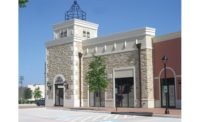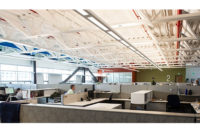With recent changes in energy codes, continuous insulation and continuous air barriers are now required in almost all climate zones. Air barriers are starting to be adopted on a state by state basis. The U.S. Department of Energy recently mandated all states must adopt a commercial building energy code that meets or exceeds ASHRAE Standard 90.1-2010 by Oct. 18, 2013, which will result in significant changes to building envelope design.
This article presents the results of an energy modeling study demonstrating that significant energy savings can be achieved on both new and retrofit construction by incorporating an EIFS with continuous insulation and air barrier protection.
ENERGY CODES
Rising energy costs and environmental concerns have driven changes in energy codes and in construction practices, which are aimed at reducing energy consumption. Rising energy costs have also resulted in an increased focus on retrofit of existing buildings to reduce energy consumption. Controlling conductive heat transfer through exterior walls and controlling air leakage through the building enclosure are two key aspects to reducing energy consumption.
Historically U.S. state energy codes have focused on conductive heat transfer through prescriptive R-value and U-values for building enclosure systems. Lesser focus has been place on air leakage control and air barrier requirements. The first modern North American quantitative code requirement for air barrier materials was implemented in the National Building Code of Canada in the mid 1980s. In 2001 Massachusetts became the first state to incorporate a quantitative air barrier code requirement, Wisconsin, Michigan, Rhode Island, Georgia, Minnesota and Florida have since included air barrier requirements in their state codes.
EXTERIOR INSULATING AND FINISH SYSTEM
The insulation benefits of EIFS have long been recognized and with recent energy code changes EIFS is becoming an increasingly attractive and economical approach to providing continuous insulation. The provision of continuous insulation requires that the exterior cladding be cantilevered out from the wall structure by the thickness of the insulation. This cantilevering of loads can present structural challenges resulting in increased structural costs. This can be particularly challenging for retrofit projects where the original walls were not designed to accommodate these additional loads. The light weight of EIFS makes it a very attractive approach for the provision of continuous insulation for both new construction and for retrofit applications. Next generation, drainable EIFS also incorporate continuous air barriers as part of the cladding system.
ENERGY MODELING STUDY (NOTE 1)
The study evaluated the relative benefits of two continuous insulation EIFS—one with an air barrier and one without—for energy retrofit and new construction applications.
A prototype medium three-story office building was modeled for Dallas, Seattle and Toronto climates. Various scenarios for retrofit of existing buildings and for design upgrades for new construction were considered. The baseline case buildings were modeled as meeting the minimum requirements of ASHRAE 90.1-2004 for existing buildings and ASHRAE 90.1-2007 for new buildings. A baseline air leakage rate of 1.55 cfm/sf of above grade envelope surface normalized to 1.57 psf (75 Pa) was used.¹
Existing Building Retrofit:
Two EIFS retrofit cases were considered for each climate zone. For retrofit case one a 2-inch EIFS (without an air barrier) was added to the baseline model without changing the building air leakage rate. For retrofit case two a 2-inch system with an air barrier was added to the baseline model with the air leakage rate reduced to 0.4 cfm/ft² at 1.57 psf (75 Pa) pressure difference normalized to 0.08 psf (4 Pa).
New Building – Energy Design Upgrade:
The Energy Design Upgrade cases replace brick with an EIFS with an air barrier. In all upgraded cases the air leakage rate was reduced to 0.25cfm/ft². The thickness of the exterior EIFS was varied from code minimum up to a maximum of 10 inches of EPS insulation.
ENERGY MODEL KEY FINDINGS
Results of the modeling showed that significant energy savings can be achieved for both retrofit and new construction by adding an EIFS with an air barrier. Annualized heating and cooling energy savings ranged from approximately 20 to 45 percent with greater savings achieved in colder climates. In addition, reducing air leakage with a continuous air barrier had a much greater effect than adding continuous insulation alone.
CONCLUSIONS
The modeling demonstrates that both an EIFS and one with an air barrier are effective in reducing energy consumption both for new construction and for retrofit applications. The air barrier that is included as part of the EIFS offers significant improvement in energy efficiency of the assembly.
EIFS with an air barrier meet the 2012 continuous insulation energy code requirements. The adhesive attachment of the system eliminates thermal bridging, and the light weight of the system allows for additional continuous insulation to be added with minimal structural implications.
Although durability was not considered within this study, the drainability of the EIFS with air barrier and the hygrothermal properties of EIFS also improve the long term durability of the wall assembly. The beneficial hygrothermal properties of EIFS have been demonstrated in prior studies by Oak Ridge National Laboratories.² W&C
FOOTNOTES:
1 ASHRAE 2009 Handbook of Fundamentals, p. 16.25
2 ORNL / EIMA exterior wall cladding performance study dated August 15, 2008 for additional information on the moisture control properties of EIFS
wall assemblies.






